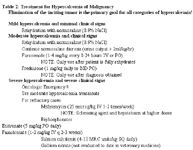Paraneoplastic syndromes: What's the big deal? (Proceedings)
Paraneoplastic syndromes (PNS) are neoplasm-associated alterations in bodily structure and/or function that occur distant to the tumor. They are an extremely diverse group of clinical aberrations that are associated with the non-invasive actions of the tumor.
Paraneoplastic syndromes (PNS) are neoplasm-associated alterations in bodily structure and/or function that occur distant to the tumor. They are an extremely diverse group of clinical aberrations that are associated with the non-invasive actions of the tumor. In many situations, the PNS parallels the underlying malignancy, and therefore, successful treatment of the tumor leads to disappearance of the PNS. Alternatively, recurrence of the PNS after successful treatment signals recurrence of the tumor, and the return of the PNS often significantly precedes the gross recurrence of the tumor.
PNS are often the first sign of malignancy, or the PNS may be a hallmark of a certain tumor type. Therefore, an understanding and appreciation for the types and causes of these syndromes are paramount for early cancer detection and appropriate therapy. In addition, PNS can cause greater morbidity than that associated with the actual tumor. Unfortunately, some PNS can be so severe that appropriate therapies may not be instituted against the tumor, although the tumor may in fact be readily treatable (e.g. hypercalcemic lymphoma).

Table I: Paraneoplastic Syndromes and Associated Tumors
The causes of PNS are quite variable; however, they are usually caused by the production of small molecules, which are released into the circulation to cause effects at distant sites. In addition, there are many non-endocrine PNS with no known etiology. Though recognized more commonly in human cancer patients, PNS do occur in veterinary medicine. Table 1 summarizes the most common PNS of dogs and cats with the tumors that cause them. This presentation will review the wide range of PNS seen in veterinary oncology with a system-based approach and each system-section contains a brief discussion of comparative aspects to related human PNS when appropriate.

Table 2: Treatment for Hypercalcemia of Malignancy
Selected References
John, W.J., Patchell, R.A., and Foon, K.A. Paraneoplastic Syndromes. In: V.T. DeVita, S. Hellman and S.A. Rosenberg (eds.), Cancer: Principles & Practice of Oncology, pp. 2397-2422, Philadelphia: Lippincott-Raven Publishers. 1997.
Crowe, S.E. and Oliver, J. Cancer Cachexia. Compend Contin Educ Pract Vet, 3: 681-690, 1981.
Weir, E.C., Norrdin, R.W., Matus, R.E., Brooks, M.B., Broadus, A.E., Mitnik, M., Johnston, S.D., and Insogna, K.L. Humoral hypercalcemia of malignancy in canine lymphosarcoma. Endocrinology, 122: 602-608, 1988.
Bergman, P.J., Bruyette, D.S., Coyne, B.E., et al. Canine clinical peripheral neuropathy associated with pancreatic islet cell carcinoma. Prog Vet Neurol, 5: 57-62, 1994.
Bergman P.J. Paraneoplastic Syndromes. In: Small Animal Clinical Oncology (3rd Edition), Withrow SJ & MacEwen EG (eds.), WB Saunders Inc., Philadelphia, PA, 2002.
Bergman PJ. Paraneoplastic Syndromes. In: Small Animal Clinical Oncology (4th Edition), Withrow SJ & Vail DM (eds.), Elsevier Saunders Inc., St. Louis, MO, 2007.
Cavana P, Sammartano F, Capucchio MT, Catalano D, Valazza A, Farca AM. Peripheral neuropathy in a cat with renal lymphoma. J Feline Med Surg. 2009 Oct;11(10):869-72. Epub 2009 May 21.
Nishifuji K, Olivry T, Ishii K, Iwasaki T, Amagai M. IgG autoantibodies directed against desmoglein 3 cause dissociation of keratinocytes in canine pemphigus vulgaris and paraneoplastic pemphigus. Vet Immunol Immunopathol. 2007 Jun 15;117(3-4):209-21. Epub 2007 Feb 16.
Zini E, Glaus TM, Minuto F, Arvigo M, Hauser B, Reusch CE. Paraneoplastic hypoglycemia due to an insulin-like growth factor type-II secreting hepatocellular carcinoma in a dog. J Vet Intern Med. 2007 Jan-Feb;21(1):193-5.
Snead EC. A case of bilateral renal lymphosarcoma with secondary polycythaemia and paraneoplastic syndromes of hypoglycaemia and uveitis in an English Springer Spaniel. Vet Comp Oncol. 2005 Sep;3(3):139-44.
Marconato L, Albanese F, Viacava P, Marchetti V, Abramo F. Paraneoplastic alopecia associated with hepatocellular carcinoma in a cat. Vet Dermatol. 2007 Aug;18(4):267-71.